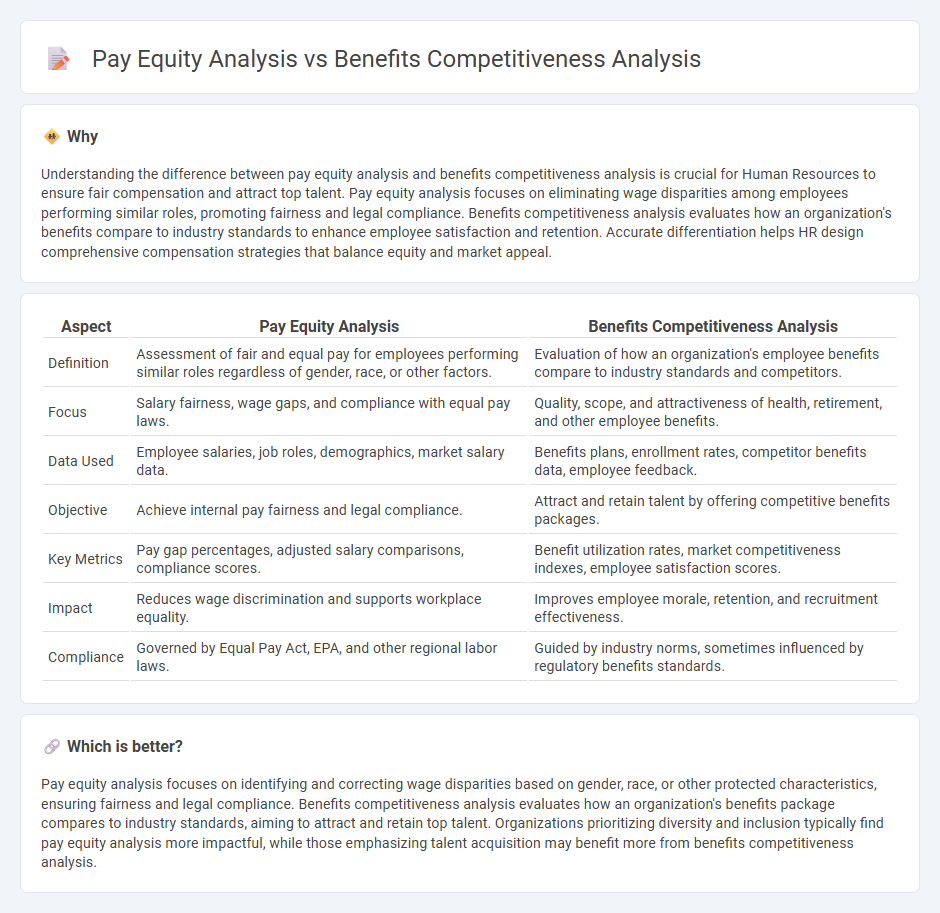
Pay equity analysis examines wage disparities across gender, race, and roles to ensure fair compensation practices within an organization, focusing on compliance and employee satisfaction. Benefits competitiveness analysis evaluates the attractiveness of an organization's benefits package compared to industry standards, aiming to enhance talent retention and recruitment. Explore detailed strategies to optimize human resources through comprehensive pay equity and benefits competitiveness assessments.
Why it is important
Understanding the difference between pay equity analysis and benefits competitiveness analysis is crucial for Human Resources to ensure fair compensation and attract top talent. Pay equity analysis focuses on eliminating wage disparities among employees performing similar roles, promoting fairness and legal compliance. Benefits competitiveness analysis evaluates how an organization's benefits compare to industry standards to enhance employee satisfaction and retention. Accurate differentiation helps HR design comprehensive compensation strategies that balance equity and market appeal.
Comparison Table
| Aspect | Pay Equity Analysis | Benefits Competitiveness Analysis |
|---|---|---|
| Definition | Assessment of fair and equal pay for employees performing similar roles regardless of gender, race, or other factors. | Evaluation of how an organization's employee benefits compare to industry standards and competitors. |
| Focus | Salary fairness, wage gaps, and compliance with equal pay laws. | Quality, scope, and attractiveness of health, retirement, and other employee benefits. |
| Data Used | Employee salaries, job roles, demographics, market salary data. | Benefits plans, enrollment rates, competitor benefits data, employee feedback. |
| Objective | Achieve internal pay fairness and legal compliance. | Attract and retain talent by offering competitive benefits packages. |
| Key Metrics | Pay gap percentages, adjusted salary comparisons, compliance scores. | Benefit utilization rates, market competitiveness indexes, employee satisfaction scores. |
| Impact | Reduces wage discrimination and supports workplace equality. | Improves employee morale, retention, and recruitment effectiveness. |
| Compliance | Governed by Equal Pay Act, EPA, and other regional labor laws. | Guided by industry norms, sometimes influenced by regulatory benefits standards. |
Which is better?
Pay equity analysis focuses on identifying and correcting wage disparities based on gender, race, or other protected characteristics, ensuring fairness and legal compliance. Benefits competitiveness analysis evaluates how an organization's benefits package compares to industry standards, aiming to attract and retain top talent. Organizations prioritizing diversity and inclusion typically find pay equity analysis more impactful, while those emphasizing talent acquisition may benefit more from benefits competitiveness analysis.
Connection
Pay equity analysis ensures fair compensation across employee groups by identifying wage disparities based on factors such as gender, race, or job role, promoting fairness and compliance with labor laws. Benefits competitiveness analysis evaluates employee benefits packages against industry standards to attract and retain talent while meeting workforce expectations. Both analyses intersect by providing comprehensive insights into total rewards strategy, enhancing organizational equity, employee satisfaction, and competitive positioning in the labor market.
Key Terms
**Benefits Competitiveness Analysis:**
Benefits Competitiveness Analysis evaluates how a company's total compensation package stacks up against industry standards, focusing on employee benefits like health insurance, retirement plans, wellness programs, and paid time off. This analysis identifies gaps and opportunities for enhancing benefit offerings to attract and retain top talent while controlling costs. Explore how Benefits Competitiveness Analysis can strategically improve your workforce satisfaction and business performance.
Benchmarking
Benefits competitiveness analysis evaluates how an organization's employee benefits compare with industry standards, helping attract and retain top talent by identifying gaps and opportunities for improvement. Pay equity analysis ensures fair and unbiased compensation across different demographics, promoting diversity and reducing legal risks related to wage discrimination. Explore our detailed insights to understand how combining these analyses can enhance organizational effectiveness and employee satisfaction.
Total Rewards
Total Rewards competitiveness analysis evaluates how an organization's compensation, benefits, and incentives compare to market standards, driving talent attraction and retention by aligning with industry benchmarks. Pay equity analysis ensures fair and unbiased compensation across employees by identifying and addressing disparities related to gender, race, or other factors, fostering inclusivity and compliance with equal pay regulations. Explore further to understand how integrating both analyses enhances a comprehensive Total Rewards strategy.
Source and External Links
5 Benefits of an Effective Competitive Pricing Analysis - Competitive pricing analysis helps businesses achieve higher profit margins, identify new market opportunities, and mitigate risks from pricing errors by regularly monitoring competitor prices.
A Look at the Benefits of Competitive Analysis - Competitive analysis enables companies to better understand their market, target customers more effectively, and anticipate market trends and potential economic shifts by systematically tracking competitors' products, prices, and strategies.
How Competitive Analysis Will Benefit Your Company - Analyzing competitors' strengths and weaknesses allows businesses to improve their own strategies, optimize resource allocation, and uncover new growth opportunities within their target market.
 dowidth.com
dowidth.com